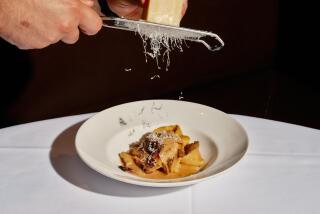A Pasta Without Wheat
What started as a dare has resulted in a new pasta with superior nutritional value and a significant dietary advantage: It can be eaten by pasta lovers who are allergic to wheat.
This is Papadini--pasta manufactured in India from lentils and beans. Its creator is Anand Sarabhai, an Indian scientist whose field is molecular biology, not food. But when a friend bet Sarabhai that it would be impossible to make pasta without using a cereal product, he could not resist the challenge. It took Sarabhai only a year to win.
“There’s no cheating in this, no 10% wheat,” he emphasized during a recent visit to Los Angeles. Now living in New York, Sarabhai is from Ahmedabad on the west coast of India. The pasta is manufactured and packaged there and shipped by air to the United States.
Production is small. The first to carry the pasta import was Dean & De Luca in New York City. There, Papadini is sold dry; it also goes into deli salads. The Broadway Deli in Santa Monica placed Papadini on sale two weeks ago. And Michel Richard, chef-owner of Citrus, is introducing a Papadini dish there this week.
Sarabhai is pleased that the product has passed what he calls “the gourmet shop test.” He has chosen not to distribute it in India nor to aim it where it would surely have great success: the health food market.
Made without preservatives, Papadini is high in dietary fiber and low in fat. Four ounces will provide 40% of the daily protein requirement, Sarabhai said. The oil in the ingredients listed on the label occurs naturally in beans and lentils. Other additions include salt and a small dash of asafeotida, an Indian seasoning. “It gives a nice flavor,” Sarabhai said.
A 100-gram (slightly less than 4-ounce) packet of Papadini sells for $2.50 at the Broadway Deli. That amount will yield two ample main-dish servings or four appetizer servings.
Furthermore, the pasta cooks in only a minute or two, a boon to the cook in a hurry. And it retains its pleasant, firm-to-the-bite texture even when cold.
Sarabhai chose the name Papadini because it sounds both Indian and European. Think of papardelle , the broad Italian noodle, and pappadums , the crisp lentil wafers eaten in India. Available shapes include circles that look just like pappadums, squares and fettuccine-like strands.
Papadini comes plain or seasoned. New Yorkers are lining up for the black-pepper and red-chile versions, Sarabhai said. (The chiles come from Serisa, a village in Gujarat noted for the quality of its crop.) Other flavorings are green chiles, cilantro and fenugreek .
The pasta’s bean and lentil flavors are subtle and nonintrusive. It can be used for anything from chips--it’s wonderfully light and crisp when deep-fried--to serious California cuisine. Alain Giraud, chef de cuisine at Citrus, tried it out in a variety of dishes when Sarabhai was in town. Giraud selected rounds of cilantro Papadini for a pasta salad with tomato vinaigrette, garnished with asparagus spears and strips of tomato. Squares of plain Papadini went into a hot dish of crayfish and fresh shiitake in mushroom sauce, and wide strips of plain lentil Papadini inspired a luxurious concoction of salmon, mussels and pasta in an unctuous saffron-mustard sauce.
Sarabhai doesn’t see anything out of the ordinary in turning to pasta from molecular biology. “Scientists are similar to artists,” he said. “They are people who are creative, and they love food.”
The Broadway Deli has plain lentil and cilantro-lentil Papadini in square and circle shapes. Mung bean, masoor (an Indian lentil), and chana (garbanzo bean) flavors are available there only in circle shapes. The address is 1457 Third Street Promenade, Santa Monica. (213) 451-0616.
More to Read
Eat your way across L.A.
Get our weekly Tasting Notes newsletter for reviews, news and more.
You may occasionally receive promotional content from the Los Angeles Times.









